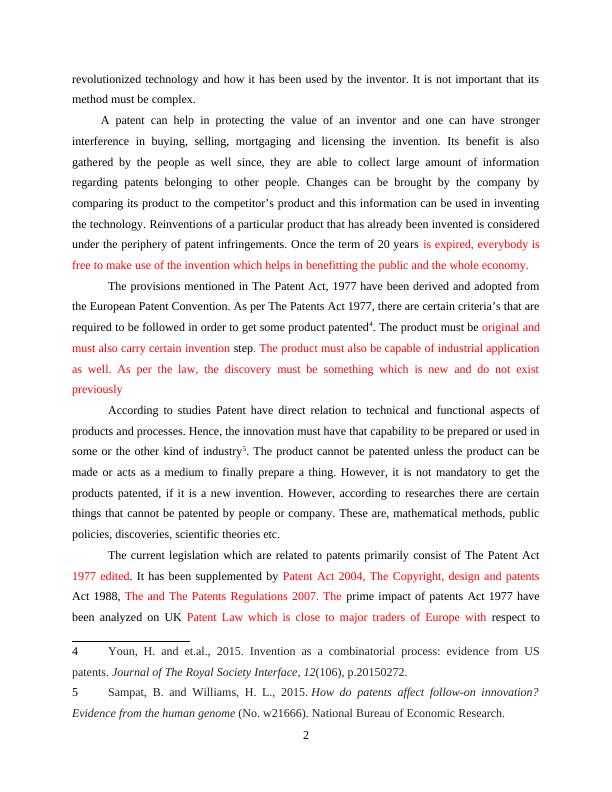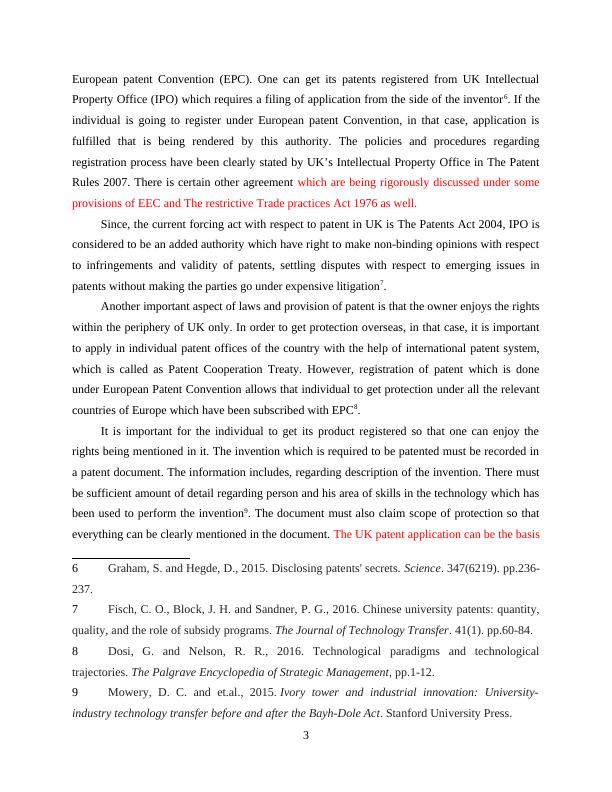Ask a question from expert
Intellectual Property & Commerce Patents
17 Pages7251 Words481 Views
Added on 2020-07-22
About This Document
Sport, Intellectual Property & Commerce Patent is the protection which is provided to the organisation or an individual through which they can protect the technology used for designing their products from theft[1]. A patent helps in giving right to the inventor of any technology or product to protect others from preparing, utilizing and further selling its discovery without prior authorisation of inventor.
Intellectual Property & Commerce Patents
Added on 2020-07-22
BookmarkShareRelated Documents
Sport, Intellectual Property& Commerce

Patent is the protection which is provided to the organisation or an individualthrough which they can protect the technology used for designing their products from theft1.Patents assist in providing certain rights to an individual or an organisation to prevent theirinnovation from imitation. Sports industry is vast and wide and there are many types of sportingactivities played all around the world. There are various sporting equipment manufacturingcompanies who produces different types of equipments for particular types of sport2. Forexample, a cricket bat is of specific shape and type but has been manufactured by differentcompanies across United Kingdom by using different types of wood in order to prevent breach ofpatent law. Thus, patents helps in promoting innovation and encourage technological advancesthat results in better sporting equipments for professional and disabled sport and for the public.In accordance with this context, the following assignment will demonstrate the importance ofpatents for sporting industries. The implications and benefits enjoyed by sports organisation willbe assessed in this assignment. By analysing the types of equipments for professional anddisabled sport, the innovation takes place because of patents will be assessed in this assignment.A patent helps in giving right to the inventor of any technology or product to protect othersfrom preparing, utilizing and further selling its discovery without prior authorisation of inventor.The inventor get access to short term monopoly where period can be specified as 20 years. It isthen transferred to public domain. The main objective of patent is encouraging improvementsand innovartion in industrial practices3.Patent intends to cover certain products and processes that contains any new functionalityor modernized technical aspects. Hence, the major concern of patent is on how things work, howthey do it, what they do, with what kind of material they are prepared of or what is the method ofthe product’s or technology’s preparation. Majority of the patents have stronger impact of1Schiff, E., 2015.Industrialization without National Patents: The Netherlands, 1869-1912; Switzerland, 1850-1907. Princeton University Press.2Dorn, D. and et.al., 2016.Foreign competition and domestic innovation: Evidence fromUS patents(No. w22879). National Bureau of Economic Research.3Mgbeoji, I., 2014.Global biopiracy: patents, plants, and indigenous knowledge. ubcPress.Nard, C. A., 2014.The Law of Patents. Wolters Kluwer Law & Business.1

revolutionized technology and how it has been used by the inventor. It is not important that itsmethod must be complex. A patent can help in protecting the value of an inventor and one can have strongerinterference in buying, selling, mortgaging and licensing the invention. Its benefit is alsogathered by the people as well since, they are able to collect large amount of informationregarding patents belonging to other people. Changes can be brought by the company bycomparing its product to the competitor’s product and this information can be used in inventingthe technology. Reinventions of a particular product that has already been invented is consideredunder the periphery of patent infringements. Once the term of 20 years is expired, everybody isfree to make use of the invention which helps in benefitting the public and the whole economy. The provisions mentioned in The Patent Act, 1977 have been derived and adopted fromthe European Patent Convention. As per The Patents Act 1977, there are certain criteria’s that arerequired to be followed in order to get some product patented4. The product must be original andmust also carry certain invention step. The product must also be capable of industrial applicationas well. As per the law, the discovery must be something which is new and do not existpreviouslyAccording to studies Patent have direct relation to technical and functional aspects ofproducts and processes. Hence, the innovation must have that capability to be prepared or used insome or the other kind of industry5. The product cannot be patented unless the product can bemade or acts as a medium to finally prepare a thing. However, it is not mandatory to get theproducts patented, if it is a new invention. However, according to researches there are certainthings that cannot be patented by people or company. These are, mathematical methods, publicpolicies, discoveries, scientific theories etc. The current legislation which are related to patents primarily consist of The Patent Act1977 edited. It has been supplemented by Patent Act 2004, The Copyright, design and patentsAct 1988, The and The Patents Regulations 2007. The prime impact of patents Act 1977 havebeen analyzed on UK Patent Law which is close to major traders of Europe with respect to4Youn, H. and et.al., 2015. Invention as a combinatorial process: evidence from USpatents.Journal of The Royal Society Interface,12(106), p.20150272.5Sampat, B. and Williams, H. L., 2015.How do patents affect follow-on innovation?Evidence from the human genome(No. w21666). National Bureau of Economic Research.2

European patent Convention (EPC). One can get its patents registered from UK IntellectualProperty Office (IPO) which requires a filing of application from the side of the inventor6. If theindividual is going to register under European patent Convention, in that case, application isfulfilled that is being rendered by this authority. The policies and procedures regardingregistration process have been clearly stated by UK’s Intellectual Property Office in The PatentRules 2007. There is certain other agreement which are being rigorously discussed under someprovisions of EEC and The restrictive Trade practices Act 1976 as well.Since, the current forcing act with respect to patent in UK is The Patents Act 2004, IPO isconsidered to be an added authority which have right to make non-binding opinions with respectto infringements and validity of patents, settling disputes with respect to emerging issues inpatents without making the parties go under expensive litigation7. Another important aspect of laws and provision of patent is that the owner enjoys the rightswithin the periphery of UK only. In order to get protection overseas, in that case, it is importantto apply in individual patent offices of the country with the help of international patent system,which is called as Patent Cooperation Treaty. However, registration of patent which is doneunder European Patent Convention allows that individual to get protection under all the relevantcountries of Europe which have been subscribed with EPC8. It is important for the individual to get its product registered so that one can enjoy therights being mentioned in it. The invention which is required to be patented must be recorded ina patent document. The information includes, regarding description of the invention. There mustbe sufficient amount of detail regarding person and his area of skills in the technology which hasbeen used to perform the invention9. The document must also claim scope of protection so thateverything can be clearly mentioned in the document. The UK patent application can be the basis6Graham, S. and Hegde, D., 2015. Disclosing patents' secrets.Science.347(6219). pp.236-237.7Fisch, C. O., Block, J. H. and Sandner, P. G., 2016. Chinese university patents: quantity,quality, and the role of subsidy programs.The Journal of Technology Transfer.41(1). pp.60-84.8Dosi, G. and Nelson, R. R., 2016. Technological paradigms and technologicaltrajectories.The Palgrave Encyclopedia of Strategic Management, pp.1-12.9Mowery, D. C. and et.al., 2015.Ivory tower and industrial innovation: University-industry technology transfer before and after the Bayh-Dole Act. Stanford University Press.3

End of preview
Want to access all the pages? Upload your documents or become a member.
Related Documents
Case Study Analysis: Patentability and Trademarkslg...
|10
|2255
|354
Innovations in IT Systems : Assignmentlg...
|8
|1586
|152
Global Business Aspects: Protecting IP Rights, Managing Functions, Cultural Impact, Entry Strategies & Assessmentlg...
|11
|2151
|171
Australian Patent System: Review and Analysislg...
|1
|837
|457
INTELLECTUAL PROPERTY LAWlg...
|8
|2879
|205
(Solved) Innovation and Commercialization in Businesslg...
|12
|3309
|437